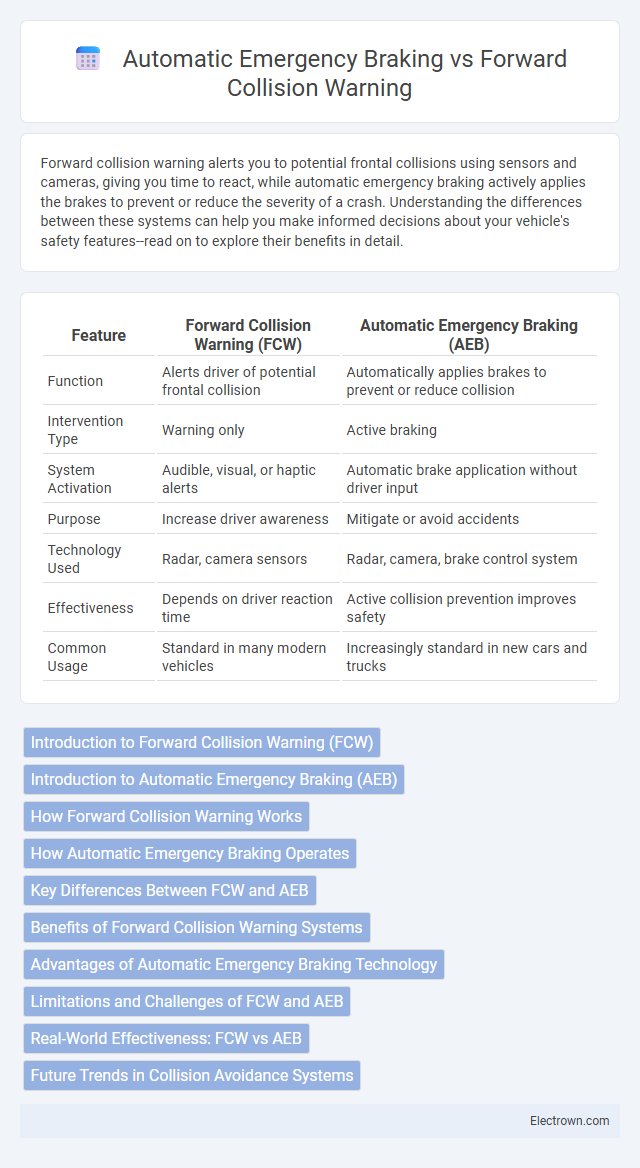Forward collision warning alerts you to potential frontal collisions using sensors and cameras, giving you time to react, while automatic emergency braking actively applies the brakes to prevent or reduce the severity of a crash. Understanding the differences between these systems can help you make informed decisions about your vehicle's safety features--read on to explore their benefits in detail.
Table of Comparison
| Feature | Forward Collision Warning (FCW) | Automatic Emergency Braking (AEB) |
|---|---|---|
| Function | Alerts driver of potential frontal collision | Automatically applies brakes to prevent or reduce collision |
| Intervention Type | Warning only | Active braking |
| System Activation | Audible, visual, or haptic alerts | Automatic brake application without driver input |
| Purpose | Increase driver awareness | Mitigate or avoid accidents |
| Technology Used | Radar, camera sensors | Radar, camera, brake control system |
| Effectiveness | Depends on driver reaction time | Active collision prevention improves safety |
| Common Usage | Standard in many modern vehicles | Increasingly standard in new cars and trucks |
Introduction to Forward Collision Warning (FCW)
Forward Collision Warning (FCW) is an advanced driver assistance system designed to detect potential frontal collisions using sensors like radar, LiDAR, or cameras. It alerts drivers through visual, auditory, or tactile warnings, enabling timely reactions to prevent accidents. FCW technology enhances road safety by reducing rear-end collisions and improving situational awareness.
Introduction to Automatic Emergency Braking (AEB)
Automatic Emergency Braking (AEB) enhances vehicle safety by detecting imminent collisions and autonomously applying brakes to reduce impact severity or prevent accidents. Unlike Forward Collision Warning (FCW), which alerts the driver of potential frontal crashes, AEB actively intervenes when the driver fails to respond in time. Your vehicle equipped with AEB offers a critical second layer of defense, seamlessly integrating sensors and braking systems to enhance road safety.
How Forward Collision Warning Works
Forward Collision Warning (FCW) uses sensors such as radar, cameras, and lidar to continuously monitor the distance and speed of vehicles ahead, alerting drivers with visual, auditory, or tactile signals when a potential collision is detected. This system analyzes real-time data to assess the risk, giving You crucial seconds to react before impact. Unlike Automatic Emergency Braking (AEB), FCW does not intervene by applying brakes but relies on Driver action to avoid accidents.
How Automatic Emergency Braking Operates
Automatic Emergency Braking (AEB) operates by using sensors such as radar, lidar, or cameras to continuously monitor the distance and speed between the vehicle and potential obstacles. When the system detects an imminent collision, it first issues warnings to alert the driver and then autonomously applies the brakes to reduce speed or stop the vehicle if the driver does not respond in time. This proactive intervention helps mitigate crash severity or avoid collisions entirely, differentiating it from Forward Collision Warning, which solely alerts without initiating braking.
Key Differences Between FCW and AEB
Forward Collision Warning (FCW) alerts drivers to potential frontal collisions through visual, auditory, or tactile warnings, prompting you to take corrective action. Automatic Emergency Braking (AEB) goes a step further by autonomously applying brakes if the driver fails to respond, significantly reducing impact risk. The key difference lies in FCW being a passive alert system, whereas AEB actively intervenes to prevent or mitigate crashes.
Benefits of Forward Collision Warning Systems
Forward Collision Warning (FCW) systems enhance road safety by providing timely alerts to drivers about potential frontal collisions, reducing reaction times significantly. These systems leverage radar and camera sensors to detect obstacles and traffic patterns, helping to prevent accidents before they occur. FCW improves situational awareness, lowers crash severity, and supports safer driving in heavy traffic and adverse conditions.
Advantages of Automatic Emergency Braking Technology
Automatic Emergency Braking (AEB) technology actively intervenes to reduce collision severity or prevent accidents by applying brakes autonomously, enhancing driver reaction time and minimizing human error. It offers significant safety advantages by reducing rear-end collisions and mitigating injury risks compared to Forward Collision Warning (FCW), which only alerts drivers without taking control. The integration of sensors and advanced algorithms allows AEB systems to respond faster and more accurately to imminent crashes, making it a critical advancement in vehicle safety technology.
Limitations and Challenges of FCW and AEB
Forward collision warning (FCW) systems face limitations such as false alerts caused by adverse weather, complex urban environments, and sensor obstructions. Automatic emergency braking (AEB) struggles with challenges including delayed response in low-visibility conditions, difficulty in detecting stationary objects, and potential abrupt braking that may cause secondary collisions. Both technologies require continuous advancements in sensor accuracy, machine learning algorithms, and integration with other driver-assistance systems to overcome environmental and technical constraints.
Real-World Effectiveness: FCW vs AEB
Forward Collision Warning (FCW) alerts drivers to potential collisions through visual or auditory signals, enhancing hazard awareness but relying heavily on driver reaction time. Automatic Emergency Braking (AEB) actively intervenes by applying brakes when a collision risk is detected, significantly reducing crash severity and frequency in real-world conditions. Your safety improves more substantially with AEB, as studies show it decreases rear-end collisions by up to 50%, while FCW alone primarily enhances driver response without automatic corrective action.
Future Trends in Collision Avoidance Systems
Forward collision warning and automatic emergency braking represent critical advancements in vehicle safety technology, evolving towards higher levels of automation and integration with AI-driven systems. Future trends in collision avoidance systems emphasize enhanced sensor fusion, machine learning algorithms, and vehicle-to-everything (V2X) communication to predict and prevent crashes more reliably. These innovations will empower your car to anticipate hazards with greater accuracy, fostering proactive safety measures and reducing accident rates significantly.
Forward collision warning vs Automatic emergency braking Infographic

 electrown.com
electrown.com